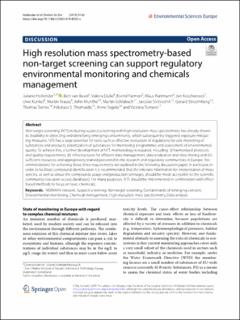| dc.contributor.author | Hollender, Juliane | |
| dc.contributor.author | van Bavel, Bert | |
| dc.contributor.author | Dulio, Valeria | |
| dc.contributor.author | Farmen, Eivind | |
| dc.contributor.author | Furtmann, Klaus | |
| dc.contributor.author | Koschorreck, Jan | |
| dc.contributor.author | Kunkel, Uwe | |
| dc.contributor.author | Krauss, Martin | |
| dc.contributor.author | Munthe, John | |
| dc.contributor.author | Schlabach, Martin | |
| dc.contributor.author | Slobodnik, Jaroslav | |
| dc.contributor.author | Stroomberg, Gerard | |
| dc.contributor.author | Ternes, Thomas A | |
| dc.contributor.author | Thomaidis, Nikolaos S. | |
| dc.contributor.author | Togola, Anne | |
| dc.contributor.author | Tornero, Victoria | |
| dc.date.accessioned | 2020-02-26T13:48:38Z | |
| dc.date.available | 2020-02-26T13:48:38Z | |
| dc.date.created | 2020-01-09T16:19:10Z | |
| dc.date.issued | 2019 | |
| dc.identifier.citation | Environmetnal Sciences Europe. 2019, 31, 42. | en_US |
| dc.identifier.issn | 2190-4715 | |
| dc.identifier.uri | https://hdl.handle.net/11250/2643995 | |
| dc.description.abstract | Non-target screening (NTS) including suspect screening with high resolution mass spectrometry has already shown its feasibility in detecting and identifying emerging contaminants, which subsequently triggered exposure mitigating measures. NTS has a large potential for tasks such as effective evaluation of regulations for safe marketing of substances and products, prioritization of substances for monitoring programmes and assessment of environmental quality. To achieve this, a further development of NTS methodology is required, including: (i) harmonized protocols and quality requirements, (ii) infrastructures for efficient data management, data evaluation and data sharing and (iii) sufficient resources and appropriately trained personnel in the research and regulatory communities in Europe. Recommendations for achieving these three requirements are outlined in the following discussion paper. In particular, in order to facilitate compound identification it is recommended that the relevant information for interpretation of mass spectra, as well as about the compounds usage and production tonnages, should be made accessible to the scientific community (via open-access databases). For many purposes, NTS should be implemented in combination with effect-based methods to focus on toxic chemicals. | en_US |
| dc.language.iso | eng | en_US |
| dc.rights | Navngivelse 4.0 Internasjonal | * |
| dc.rights.uri | http://creativecommons.org/licenses/by/4.0/deed.no | * |
| dc.title | High resolution mass spectrometry-based non-target screening can support regulatory environmental monitoring and chemicals management | en_US |
| dc.type | Peer reviewed | en_US |
| dc.type | Journal article | en_US |
| dc.description.version | publishedVersion | en_US |
| dc.rights.holder | © The Author(s) 2019 | en_US |
| dc.source.volume | 31 | en_US |
| dc.source.journal | Environmental Sciences Europe | en_US |
| dc.source.issue | 42 | en_US |
| dc.identifier.doi | 10.1186/s12302-019-0225-x | |
| dc.identifier.cristin | 1769732 | |
| cristin.unitcode | 7460,60,0,0 | |
| cristin.unitname | Miljøkjemi | |
| cristin.ispublished | true | |
| cristin.fulltext | original | |
| cristin.qualitycode | 1 | |

